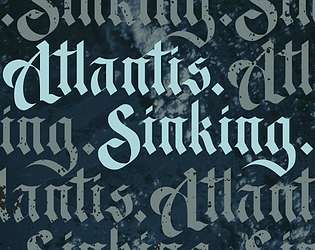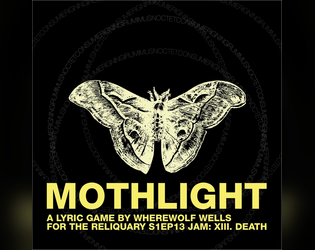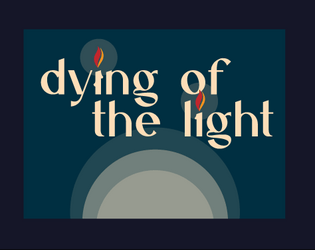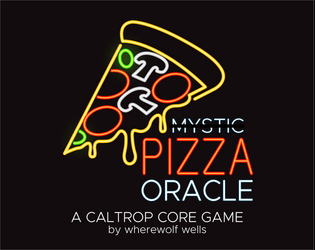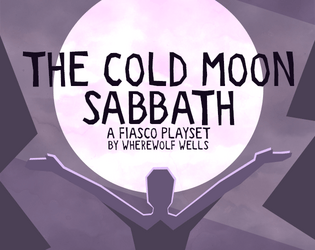a really evocative submission! I love the drama of it and the text setting really brings it all together.
wherewolf wells
Creator of
Recent community posts
I’m glad to hear you enjoyed it! I’m literally as I type working on the second edition right now, mostly just cleaning up the layout and a few mistakes like the one you mentioned, and this comment really brightened my evening. Thank you! (The 2e will be up at the end of next month, and I’ll be adjusting the download list so you’ll have access as soon as it’s live.
hi Beam! This jam is not for a fully fledged game, but rather a supplement for Bully Pulpit’s Fiasco. If you look up the game you can find the rules online. It is a very simple rules light game that requires very little preparation before you play. This game jam is about creating what is called a playset. Examples of these play sets can be found on fiascoplaysets.com. A playset changes up locations, items, and relationship types so that utilizing the same rules you could play a game set in deep space or a haunted mansion. Also sorry for the late reply, I’ve been sick since Sunday so I haven’t been too active.
If you have ever read the original Fiasco core book, or perused the many custom playsets, something that you will have seen almost everywhere is an graphic art style with loud, bold (and usually warm) colors and black and white silhouettes that have a boxy style that makes them look cut out from paper. This art style is an homage to the late Saul Bass, whose career spans over 40 years in which he worked with massive names in Hollywood like Alfred Hitchcock, Otto Preminger, Billy Wilder, Stanley Kubrick and Martin Scorsese. You can find a listicle of some of his most iconic works here.
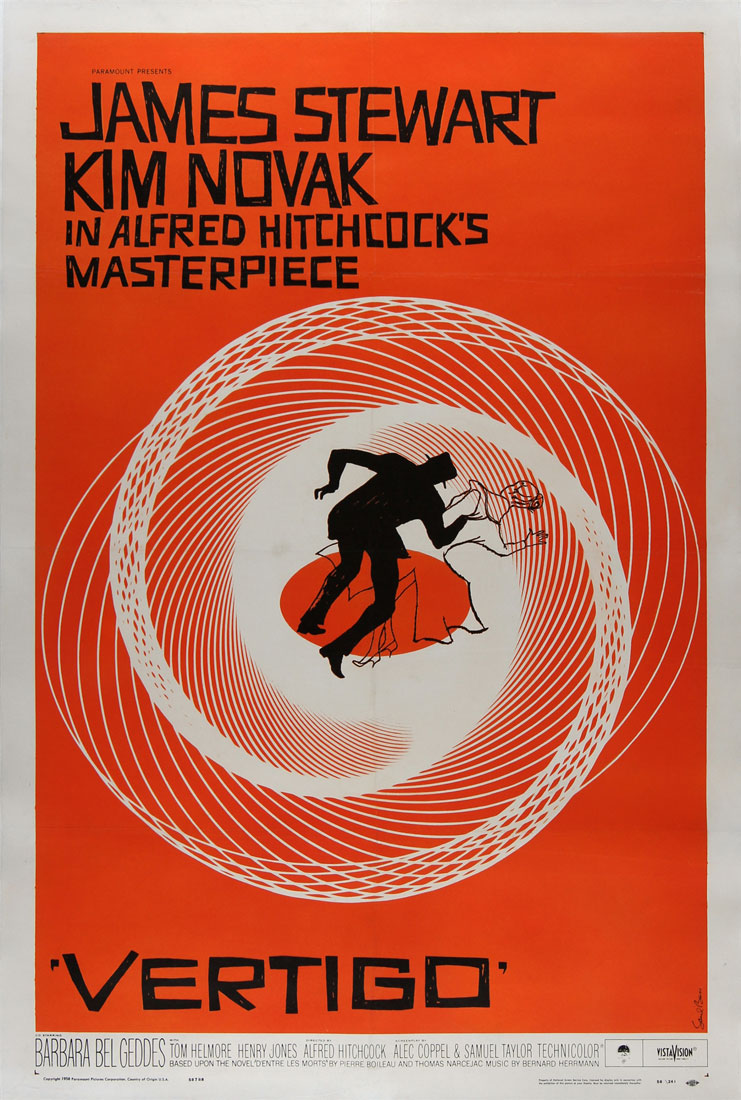
The movie poster for Vertigo (1958) is arguably one of his most well-known works and features a lot of his iconic art choices from color to font to blocky silhouettes. I'll go a bit more in depth of this in my post "Makeover Montage", but one of the fonts commonly used in Fiasco playsets is called Vertigon, a reference to the font of the movie title on this poster.
The biggest points to remember about emulation of Saul Bass' style are as follows
Color: Bass almost exclusively used warm colors (reds, pinks, oranges, and yellows) but if you feel draw to cooler colors (blues, purples, greens) the important thing to focus on is a high saturation with a high value (very little black added to the base color)
Shape: His shapes both in text and in silhouettes often feels like shapes cut out of paper with a straight blade like scissors. If you are attempting to recreate this style, I would recommend finding a portrait of someone you want to spoof and roughly tracing around the shape of the body. Don't follow too closely, but also don't be afraid to include special details like the man's hat in the Vertigo poster, or the bits missing from his leg which add some dimension to him.
Negative Space: Bass' style relied heavily on a bright saturated color taking up a lot of "empty" or negative space around the subjects of his art. Sometimes he would use this negative space to actually build other "hidden" images. One great example is the Girl Scouts logo in which three faces appear even though only one face is actually drawn using color. Especially if you're a new designer, negative space can be daunting and it feels as if you are leaving a piece unfinished, but I would encourage you to live in that negative space and enjoy the extra room.
Aside from Saul Bass' own work, if you google his name you will find hundreds of spoofs of his style, all of these are great starting points to get a better visual reference of what his style looked like. If you are looking for something a little more challenging art-wise, I might suggest you look up one of Saul's successors who is still putting out work today, Olly Moss. He has very similar design tendencies but turns Bass' style on it's head and uses silhouettes as a place to hide more little details, it's really quite a fun and intriguing style.
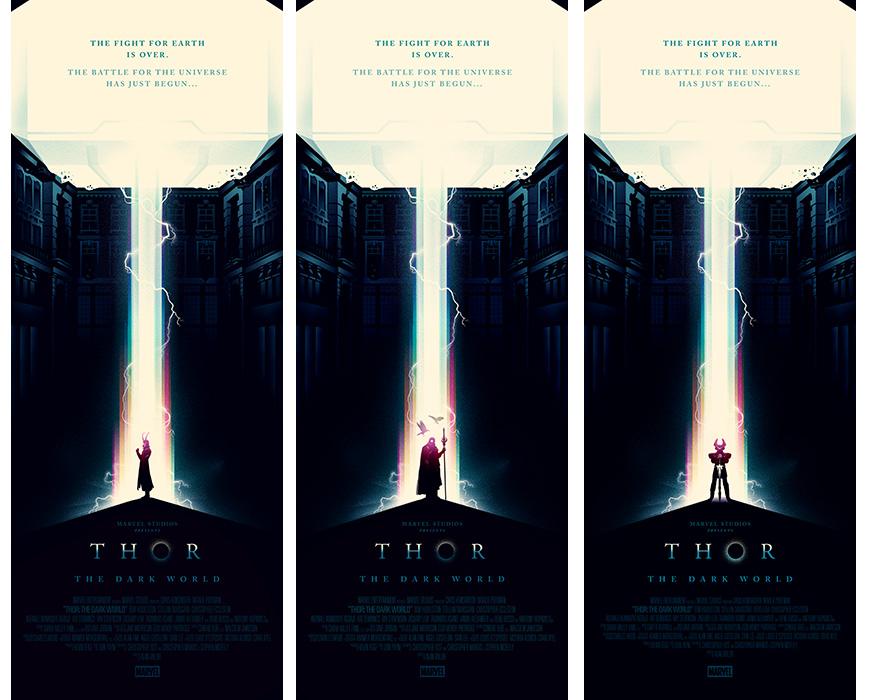
Hey y'all this post is meant to be a place to talk about what you want to design for this game jam. Feel free to toss around ideas and maybe even collab.
Please remember to keep this thread respectful and on-topic. If you are going to collab, feel free to start a new community thread where you all can talk specifics.
People, Places, and Things: This is what makes up a Fiasco Playset!
Well, mostly. Something to keep in mind when you begin designing is that it's important to create a playset that feels cohesive and also evocative. While it might be intriguing to know how former rival journalists who worked at the same coffeeshop might act in a post-apocalypse setting, it might be hard to write lists that make all of those things make sense. The other tip I have is based off a game design concept from Jay Dragon, teeth. The essential idea behind "games having teeth" is that a game setting's specificity is able to pull players into the narrative, they're the details that make you go "I don't know what that means but wow I want to find out". The challenge of writing a playset is really building up the base game's teeth and transforming that blank slate into something so specific you can't help but want to know more.
Format
Each list is written in six groups with six choices each. Fiasco is a game that uses d6s frequently and so the game encourages you to pick details from a list by rolling 2d6s. The first D6 determines that group of relationships, and the second determines a specific detail. For example Object categories in a food-based playset could be something like Fruits, Vegetables, Meat, Fish, Bread, and Dairy; and the Fruit Group could be a pear, an apple, a blueberry, a tomato, a pomegranate, or an orange. In any of the four list types, it can be difficult at first to come up with the wider categories, I suggest that you check out other playsets that interest you to get a better feeling for how to come up with the big categories.
Relationships
Relationships will be the beginning of any playset, relationship tags in Fiasco are simple phrases that are usually one to a few words that describe how two characters know each other.
Two of the most common relationship categories you will see if you look around are family and romance, they're both great options and have the most easily accessible specific relationships to pull from. Playsets generally have a couple of categories that are specific to their setting, like Betrayal, Coworkers, Former Rivals, Clandestine, Local, or even something as specific as "Curiosity jr high field trip".
Some things you'll see in a lot of Fiasco are there are certain specific relationships that are super easy to toss in and for sure can be fun, these are things like sibling rivals or enemies-to-lovers. These are fun choices and absolutely help to build a base for some of the weirder and more specific roles you can add in. In Sean Buckley's "Back to the Old House", one of the relationships is "Auntie Beryl and Uncle Death", which is a perfect example of something so specific and yet also rather nebulous that your players can build up so much story by using.
Needs
Needs express a shared desire between the two people in the relationship. These needs could be a shared goal such as "earn a teacher's respect" or goals that are in contest with each other like "end her career" from Tobie Abad's Sickening Queens. Something I find refreshing is that due to the nebulous nature of these items, even something that may be in contest like the one above, could be reinterpreted to mean they have a shared enemy, that is to say, don't worry if you use a unclear personal pronoun or leave things intentionally vague. That's part of the fun of playing is figuring out what you want those to mean.
Locations
Locations are places that the two characters have a shared history with, this could be something in their past or it could be a place that you want to play in, in your game session. The locations, I think, are a list group where you can be really evocative, like almost too much, and it still is okay. Something the original designer of Fiasco ask in their book is that if you can, they would love if you added in "The Chicken Hut" somewhere in this category, and I think part of that is it's super specific but also just means nothing. In Peter Woodworth's Hocus Focus there's a lot of great examples of locations like in "The Nightlife" there's The Velvet Room, McAnally’s Pub, Club Zero, The Green Mill jazz club, Executive Priority Health club, Coiffure Cup salon/café.
Objects
Designing objects can be a lot of fun to create something that will come up in game sessions, again and again. In the Lord of the Rings franchise, this is The One Ring, something that comes up often and has real narrative weight. Jonas Ricter's Birthday of the Goblin Princess has an incredible group of items that play out the balance between fun and dangerous and goblins and princesses, it is seriously so good.
Last Things
Something that I always do when I'm gearing up to play Fiasco is that I will make sure that everyone has a copy of the playset and I ask that everyone take a look before we go through lines and veils, and we include list items in lines and veils to make sure everyone has a good time. The flip side of this is that as designers, I think we can shared a little bit of that burden of responsibility. If you wouldn't want to play something with one of your friends, due to discomfort somewhere along that line, I'd say that's a fair enough reason to just not include that item in the first place. Good luck designing y'all!
p.s. I'll be putting a new post soon that goes over the nitty gritty of layout. You do not need to make a super detailed layout to submit your game, but I want to put together a post that helps those who want to do a layout "true-to-PBG's original Fiasco design". That post will be called "Makeover Montage" and will have some graphics about visual references made by the game, fonts, and how to properly setup your boilerplate page.
Welcome!
You bravely decided to write your first very own playset, and I have incredible new, this is one of the easiest thing you'll ever design, so let's talk about that.
What is a Fiasco Playset?
Fiasco itself is a collaborative storytelling game in which you begin play by building characters with shared history, and then you play out a series of scenes (four per person generally) telling the kind of story you might see in the length of a movie. Playsets are the narrative portion of the game that reskin the rules to play games that resemble movies, video games, books, tv shows, podcasts, and more of any genre. Some of the most popular playsets emulate action movies, slasher horror, heist movies, and sci-fi.
A playset is, generally, a document with 4 lists of 36 items each, these lists pertain to relationship types, needs, objects, and locations. That means by the time you finish, your full playset will usually have 144 items to help players build up their shared histories. If you would like to check out a massive collection of playsets, they can be found here. I absolutely recommend that if you join the game jam that you submit your playset to that website to help share it with others.
Occasionally, playsets will include extra rules like James Gabrielsen's Camp Death which has an endgame rule to determine which character is the killer or my own playset Cold Moon Sabbath which has a beginning of game roll which helps determine what kind of witches' celebration you will be having. Another way that designers will make their playset more unique is to create an alternate "Tilt Table" or "Aftermath Table" (the originals can be found on page 56 and 58, repsectively, of the Fiasco core rule book. These additions are not uncommon, but also not necessary, consider if your genre would benefit from something extra, I personally always like when someone throws in a little something extra that makes their playset unique.
In my next post, "Who? What? When? Where? and How?", I will give some tips about how to actually begin to write your own playset.
Finally, please make sure that anything you submit to this game jam is in accordance with Bully Pulpit Games' custom playset license, which can be found here.


